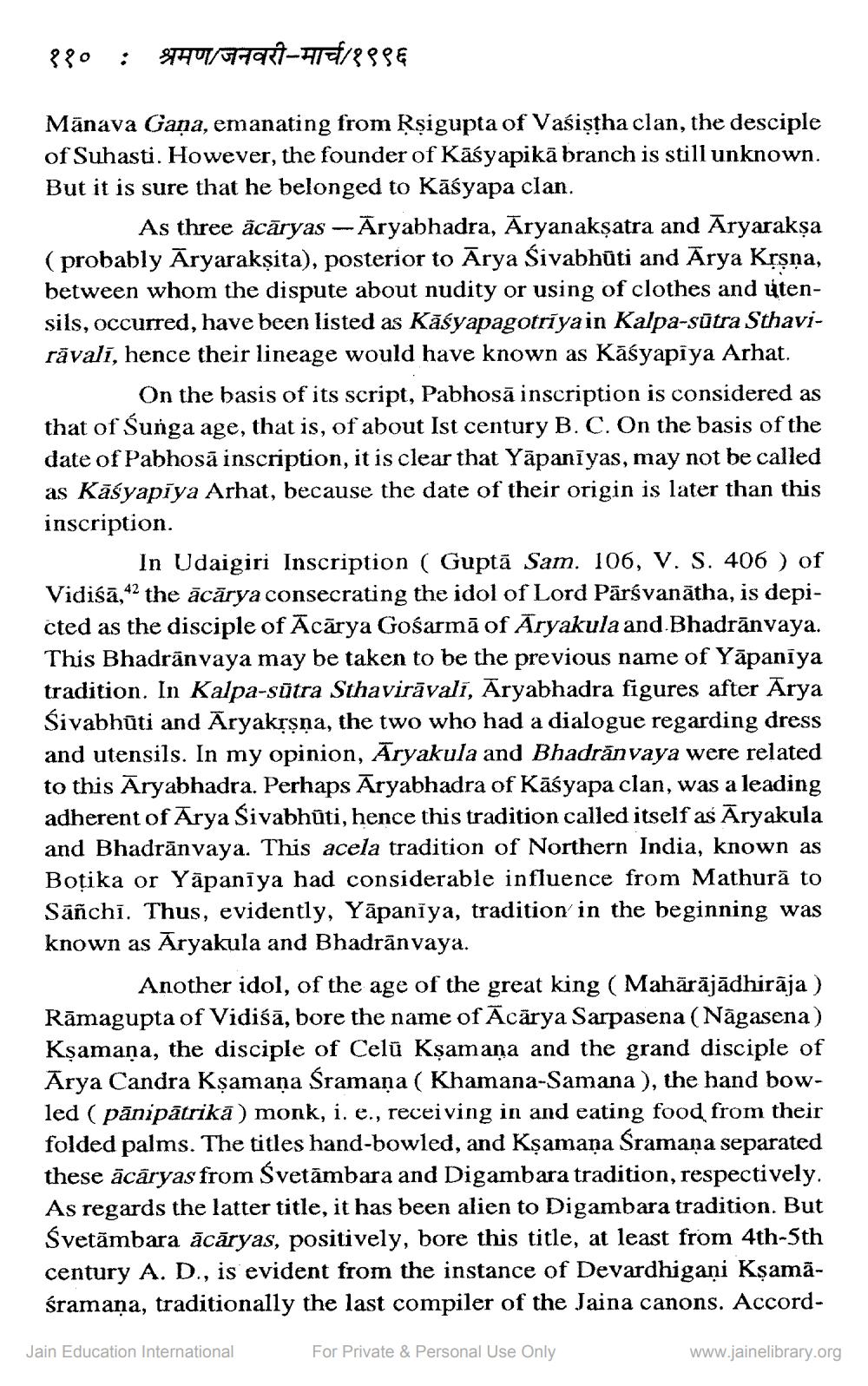________________
श्रमण/जनवरी-मार्च/१९९६
Mänava Gaṇa, emanating from Rṣigupta of Vasistha clan, the desciple of Suhasti. However, the founder of Kasyapikā branch is still unknown. But it is sure that he belonged to Kasyapa clan.
११० :
As three äcāryas -Aryabhadra, Aryanakṣatra and Aryarakṣa (probably Aryarakṣita), posterior to Ārya Śivabhūti and Arya Kṛṣṇa, between whom the dispute about nudity or using of clothes and utensils, occurred, have been listed as Kāśyapagotriyain Kalpa-sūtra Sthavirāvalī, hence their lineage would have known as Kāśyapiya Arhat.
On the basis of its script, Pabhosă inscription is considered as that of Sunga age, that is, of about Ist century B. C. On the basis of the date of Pabhosa inscription, it is clear that Yapanīyas, may not be called as Kasyapiya Arhat, because the date of their origin is later than this inscription.
In Udaigiri Inscription ( Gupta Sam. 106, V. S. 406 ) of Vidiśā,42 the ācārya consecrating the idol of Lord Parsvanatha, is depicted as the disciple of Acarya Gośarmā of Aryakula and Bhadrānvaya. This Bhadranvaya may be taken to be the previous name of Yapaniya tradition. In Kalpa-sūtra Sthavirāvalī, Āryabhadra figures after Arya Śivabhūti and Aryakṛṣṇa, the two who had a dialogue regarding dress and utensils. In my opinion, Aryakula and Bhadranvaya were related to this Aryabhadra. Perhaps Aryabhadra of Kasyapa clan, was a leading adherent of Arya Śivabhuti, hence this tradition called itself as Aryakula and Bhadranvaya. This acela tradition of Northern India, known as Botika or Yapaniya had considerable influence from Mathura to Sanchi. Thus, evidently, Yapanīya, tradition in the beginning was known as Aryakula and Bhadrānvaya.
Another idol, of the age of the great king (Mahārājādhirāja) Rāmagupta of Vidiśā, bore the name of Acarya Sarpasena (Nāgasena) Kṣamana, the disciple of Celü Kṣamana and the grand disciple of Arya Candra Kṣamana Śramana ( Khamana-Samana), the hand bowled ( panipatrikā) monk, i. e., receiving in and eating food from their folded palms. The titles hand-bowled, and Kṣamana Śramana separated these acaryas from Śvetambara and Digambara tradition, respectively. As regards the latter title, it has been alien to Digambara tradition. But Śvetämbara ācāryas, positively, bore this title, at least from 4th-5th century A. D., is evident from the instance of Devardhigani Kṣamāśramana, traditionally the last compiler of the Jaina canons. Accord
For Private & Personal Use Only
Jain Education International
www.jainelibrary.org




